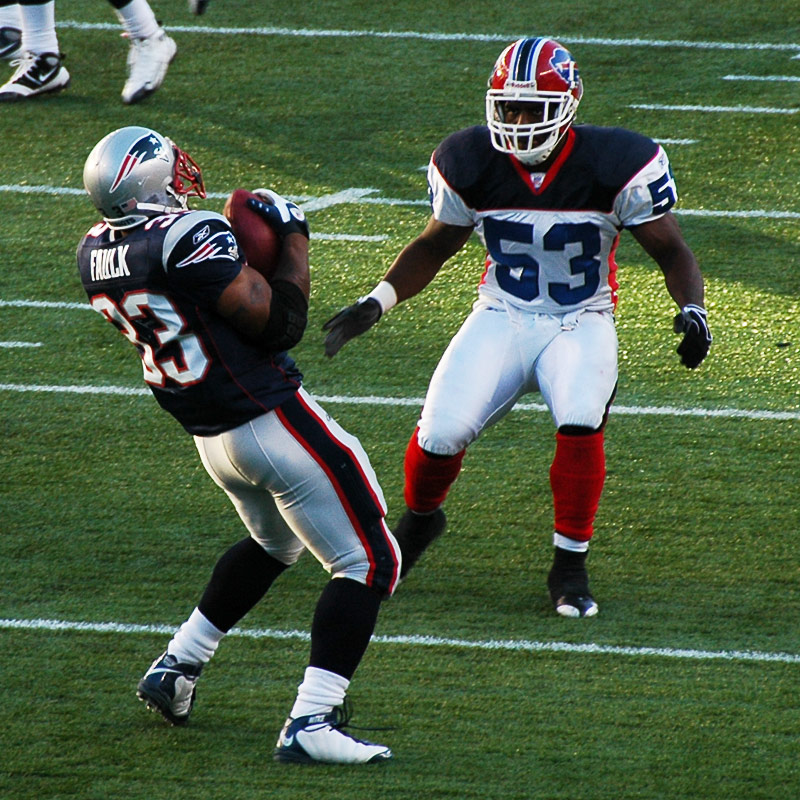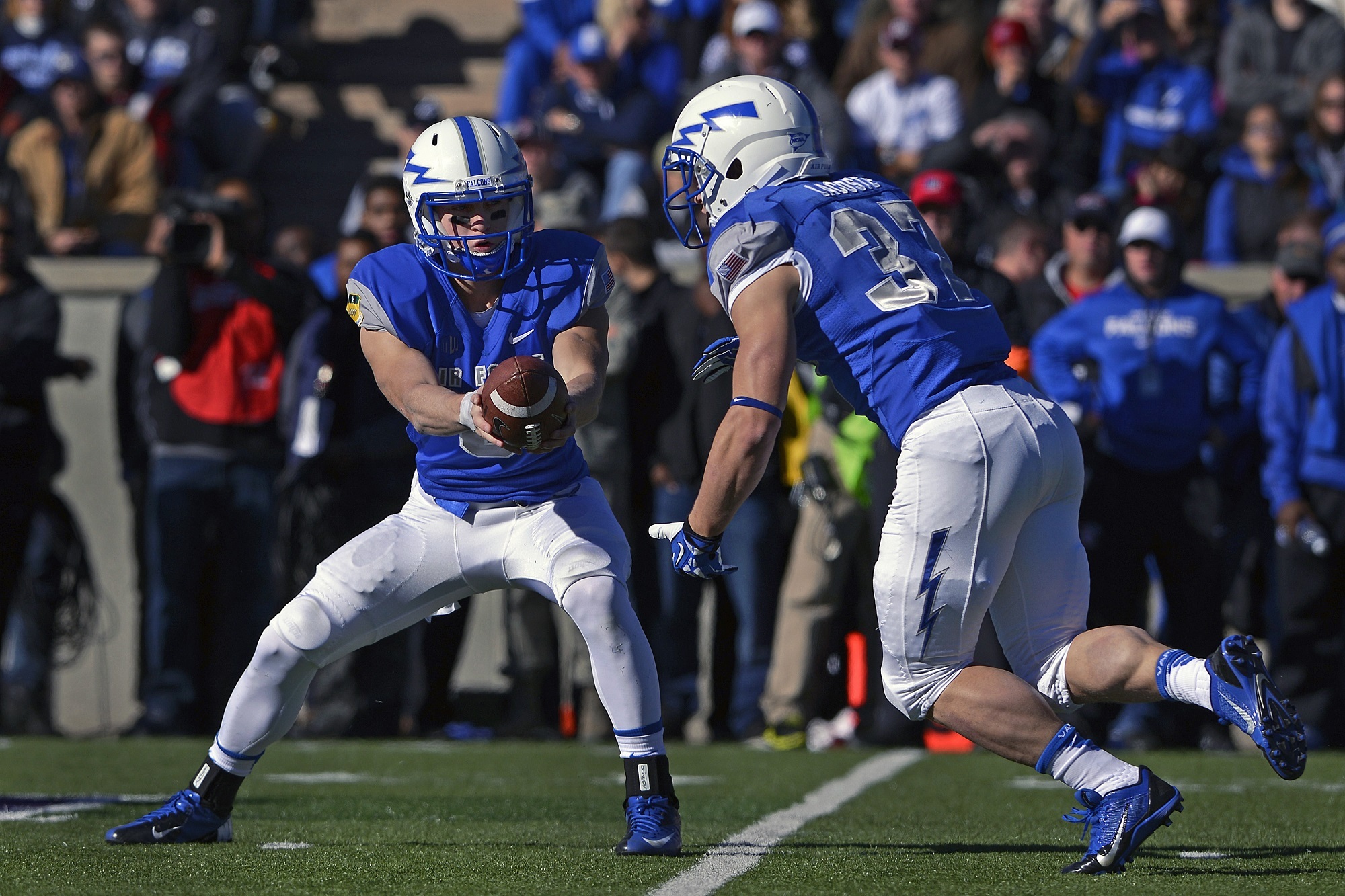Definitions Make a Difference
NCAA: National Collegiate Athletic Association … the governing body of college football
Jerseys: The home team wears dark colored jerseys and the visiting team wears light colored jerseys. The numbers and lettering must meet specific guidelines. The numbers must be of a contrasting color so they can be seen easily from the press box where the announcers are located.
Offense: The team with the ball. The area from the 50 yard like to the goal line at their back is their territory to defend.
Defense: The team trying to prevent the offense from scoring. They protect their territory from the 50 yard line to the goal line at their back.
Line of Scrimmage: The line where the ball is placed before a play is started
Backfield: The area of the field behind the line of scrimmage where the quarterback and other backs stand before a play starts
Continued Participation Without Helmet : Leave field of play for one down. If a player’s helmet comes off during a play, the player should not continue in the play and must leave the field before the next play begins.
Man in Motion: Before the snap, an end or a player in the backfield may run parallel to the line of scrimmage but not towards it
Neutral Zone: An area the width of the ball (11 inches) and stretching across the field where no player may be positioned except the center before the ball is snapped.
Fair catch: When the ball is kicked to an opposing player, that player can move one arm up over his head and wave it back and forth. This signals his desire for a fair catch. This means he cannot be tackled or blocked before or after he catches the ball.
 A fair catch is made
A fair catch is madeThere is an area the width of the receiver’s shoulders and 1 yard in from of him that no one can enter, thus giving him room to catch the ball.
If a member of the kicking team enters that area and/or interrupts the receiver’s chance to catch the ball, it constitutes a foul and a 15-yard penalty for the kicking team.
The receiver may not take more than 2 steps after catching the ball. Taking more than two steps or running with the ball constitutes a foul for delay of game and a 5-yard penalty against the receiving team.
If the fair catch is made behind the 25-yard line, the ball is placed on the 25- yard line to start play.
Downs: When a team first gets the ball, they have “First and 10” meaning they have 10 yards to go to get another first down. Second and third downs are extra chances to get to that 10 yard mark. If the team still doesn’t reach yardage for another first and 10, it becomes fourth down.
The coach has to consider where the ball is located on the field, what the score is, and how much time is left in the half or the game when making this decision. The coach has three options on fourth down:
1. Try a running or pass play to get the remaining yards for a first down. If the try fails, the ball is turned over to the other team at the spot where the fourth down ended.
2. Punt (kick) the ball to the other team
3. Try a field goal (see Scoring)
The offense moves the ball down field by continuing to get first downs until they score or a fourth down situation occurs.
Plays: There are two basic plays in football…the run play and the pass play
1. The Run Play: After the ball is snapped (hiked) to the quarterback, he can run with the ball or he can hand the ball off to another player who runs the ball as far as he can.
 The quarterback waits for the running back to grab the ball for a run play
The quarterback waits for the running back to grab the ball for a run play2. The Pass Play: The quarterback passes (throws) the ball forward to a receiver running down the field. The receiver must catch and hold onto the ball when he is tackled so it does not move or roll free when he hits the ground. If the receiver catches the ball when he is leaping into the air, he must come down with one foot inside of and not touching the sideline.
a. A lateral is a pass that is thrown to a player to the side of and slightly behind the player throwing the ball.
 A receiver stretches high for the ball. This is a great example of a defenseless player.
A receiver stretches high for the ball. This is a great example of a defenseless player.A term you will hear quite often is RPO. This stands for run-pass option. The quarterback has the option to make the play a running play or a pass play after he surveys the field and sees where all of his players are located.
Instant Replay or Booth Review: The fundamental assumption is that the call/ruling on the field is correct. However, there are calls/rulings that are questionable or unclear that must be reviewed.
There is a team of expert officials in a booth that reviews all play calls made by the officials on the field, especially if there is a questionable call. They have multiple camera angles to look at. Most touchdowns made by running plays are reviewed. All calls for targeting are reviewed (see Personal Fouls).
Other situations that may require a booth review include whether a catch is completed or where the ball needs to be placed on the field after a play. A timeout is taken by the referee on the field for the review to take place. There must be indisputable video evidence to either confirm or overturn a ruling. When a decision has been made, the head referee on the field will say:
“After further review, the previous play has been
a. confirmed : the booth saw evidence that the call was correct
b. overturned: the booth saw evidence that the call was incorrect
c. stands: the booth did not see enough evidence to confirm, but also not enough evidence to overturn
If the call is overturned, the referee will describe what happens next, depending on the reason the play was reviewed.
Touchback: A touchback occurs when a ball is kicked to the opposing team and the ball lands in or beyond the end zone. The ball is brought out to the 20-yard line for play to begin.
Live ball: A live ball is a ball in play.
Dead Ball: While the ball is in play it is called a live ball. When the ball is temporarily not in play, it is declared a dead ball. A dead ball cannot be advanced and no change of possession may occur. The ball becomes dead when one of the following occurs:
· The player with the ball runs out of bounds
· The player with the ball is downed by being tackled or by falling to the ground himself
· A forward pass touches the ground or travels out of bounds without being caught (incomplete pass)
· Any kick travels out of bounds and/or hits the goal post or crossbar in flight
· The ball is fumbled out of bounds
· A scoring play occurs
· A kickoff or free kick is touched/downed by the kicking team
· Following a punt or kick the ball travels into the end zone
· A ball is fair caught
· The ball is downed by the kicking team before being touched by the receiving team … A member of the kicking team touches the ball to stop it from moving any further—this makes the ball “downed”.
· When the referee blows his whistle to indicate the play is over
Interception: When a pass is thrown by the offense and a member of the defense catches the ball, an interception has occurred. The ball goes over to the team who caught the ball.
Fumble: When the ball is knocked loose or dropped by a member of the offense and the ball falls loose to the ground, it can be recovered by any member of either team.
FUN FACTS If you want to find your favorite player and know his position,
jersey numbers are assigned by position so…
Quarterbacks and all other backs (halfbacks, full backs, etc.) wear numbers 0-49
Snapper or Center 50-59
Guards 60-69
Tackles 70-79
Ends 80-89